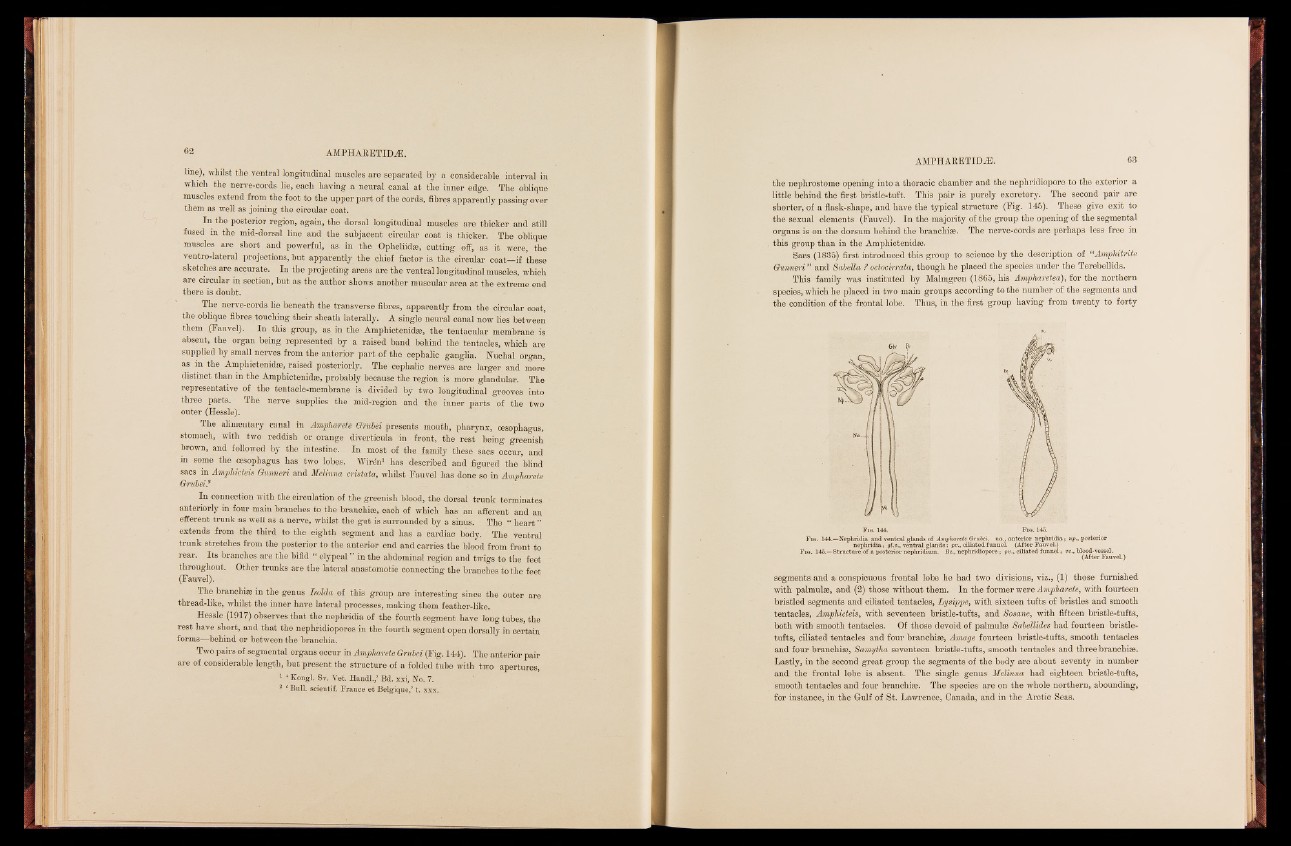
line), whilst the ventral longitudinal muscles are separated by a considerable interval in
which the nerve-cords lie, each having a neural canal at the inner edge. The oblique
muscles extend from the foot to the upper part of the cords, fibres apparently passing over
them as well as joining the circular coat.
In the posterior region, again, the dorsal longitudinal muscles are thicker and still
fused in the mid-dorsal line and the subjacent circular coat is thicker. The oblique
musoles are short and powerful, as. in the Opheliid®, cutting off, as it were, the
ventro-lateral projections, but apparently the chief factor is the circular coat—if these
sketches are accurate. In the projecting areas are the ventral longitudinal muscles, which
are circular in section, but as the author shows another muscular area at the extreme end
there is doubt.
The nerve-cords lie beneath the transverse fibres, apparently from the circular coat,
the oblique fibres touching their sheath laterally. A single neural canal now lies between
them (Fauvel), In this group, as in the Amphictenidae, the tentacular membrane is
absent, the organ being represented by a raised band behind the tentacles, which are
supplied by small nerves from the anterior part of the cephalic ganglia. Nuchal organ,
as in the Amphictenidm, raised posteriorly. The cephalic nerves are larger and more
distinct than in the Amphictenidae, probably because the region is more glandular. The
representative of the tentacle-membrane is divided by two longitudinal grooves into
three parts. The nerve supplies the mid-region and the inner parts of the two
outer (Hessle)i
The alimentary canal in Ampharete Grubei presents mouth, pharynx, oesophagus,
stomach, with two reddish or orange diverticula in front, the rest being greenish
• brown, and followed by the intestine. In most of the jamily these sacs occur, and
in some the oesophagus has two lobes. Wir&i1 has described and figured the blind
sacs m Amphieteis Gunneri and Melinna cristata, whilst Fauvel Grrubei.8 has done so in Ampharete
In connection with the circulation of the greenish blood, the dorsal trunk terminates
anteriorly in four main branches to the branchiae, each of which has an afferent and an
efferent trunk as well as a nerve, whilst the gut is surrounded by a sinus. The “ heart ”
extends from the third to the eighth segment and has a cardiac body. The ventral
trunk stretches from the posterior to the anterior end and carries the blood from front to
rear. Its branches are the bifid “ clypeal ” in the abdominal region and twigs to the feet
throughout. Other trunks are the lateral anastomotic connecting the branches to the feet
(Fauvel). •
The brancbiaa in the genus Isolda of this group are interesting since the outer are
thread-like, whilst the inner have lateral processes, making them feather-like.
Hessle (1917) observes that the nephridia of the fourth segment have long tubes, the
rest have short, and that the nephridiopores in the fourth segment open dorsally in certain
forms—behind or between the branchia.
Two pairs of segmental organs occur in Ampharete Grubei (Fig. 144). The anterior pair
are of considerable length, but present the structure of a folded tube with two apertures,
1 • Kongl. Sv. Yet. Handl./ Bd. xxi, No. 7.
2 'Bull, scieritif. France et Belgique/ t. xxx.
the nephrostome opening into a thoracic chamber and the nephridiopore to the exterior a
little behind the first bristle-tuft. This pair is purely excretory. The second pair are
shorter, of a flask-shape, and have the typical structure (Fig. 145). These give exit to
the sexual elements (Fauvel). In the majority of the group the opening of the segmental
organs is on the dorsum behind the branchiae. The nerve-cords are perhaps less free in
this group than in the Amphictenidæ.
Sars (1835) first introduced this group to science by the description of “Anvphitrite
Guimeri ” and Sabella ? octocirrata, though he placed the species under the Terebellids.
This family was instituted by Malmgren (1865, his Ampharetea), for the northern
species, which he placed in two main groups according to the number of the segments and
the condition of the frontal lobe. Thus, in the first group having from twenty to forty
FlG; 145.
Fig. 144.—Nephnreidpihar iadnida ;v egnl.vtr.,a vl egnlatnradls g olfa nAdms p; hpavr.e, tcei lGiartuebde if.u nnnae.l,. an(tAerfitoerr Fneapnhverild.)ia ; np., posterior Fig. 145.—Structure of a posterior nephridium. Be., nephridiopore : pv., ciliated funnel ; w., blo(Aodft-evre sFsaeul.vel.)
segments and a conspicuous frontal lobe he had two divisions, viz., (1) those furnished
with palmulae, and (2) those without them. In the former were Ampharete, with fourteen
bristled segments and ciliated tentacles, Lysippe, with sixteen tufts of bristles and smooth
tentacles, Amphicteis, with seventeen bristle-tufts, and Sosane, with fifteen bristle-tufts,
both with smooth tentacles. Of those devoid of palmulae Sabellides had fourteen bristle-
tufts, ciliated tentacles and four branchiae, Amage fourteen bristle-tufts, smooth tentacles
and four branchiae, Samytha seventeen bristle-tufts, smooth tentacles and three branchiae.
Lastly, in the second great group the segments of the body are about seventy in number
and the frontal lobe is absent. The single genus Melinna had eighteen bristle-tufts,
smooth tentacles and four branchiae. The species are on the whole northern, abounding,
for instance, in the Gulf of St. Lawrence, Canada, and in the Arctic Seas.